-

新人教版高中英语选修2Unit 1 Science and Scientists-Reading and thinking教学设计
Step 5: After learning the text, discuss with your peers about the following questions:1.John Snow believed Idea 2 was right. How did he finally prove it?2. Do you think John Snow would have solved this problem without the map?3. Cholera is a 19th century disease. What disease do you think is similar to cholera today?SARS and Covid-19 because they are both deadly and fatally infectious, have an unknown cause and need serious public health care to solve them urgently.keys:1. John Snow finally proved his idea because he found an outbreak that was clearly related to cholera, collected information and was able to tie cases outside the area to the polluted water.2. No. The map helped John Snow organize his ideas. He was able to identify those households that had had many deaths and check their water-drinking habits. He identified those houses that had had no deaths and surveyed their drinking habits. The evidence clearly pointed to the polluted water being the cause.3. SARS and Covid-19 because they are both deadly and fatally infectious, have an unknown cause and need serious public health care to solve them urgently.Step 6: Consolidate what you have learned by filling in the blanks:John Snow was a well-known _1___ in London in the _2__ century. He wanted to find the _3_____ of cholera in order to help people ___4_____ it. In 1854 when a cholera __5__ London, he began to gather information. He ___6__ on a map ___7___ all the dead people had lived and he found that many people who had ___8____ (drink) the dirty water from the __9____ died. So he decided that the polluted water ___10____ cholera. He suggested that the ___11__ of all water supplies should be _12______ and new methods of dealing with ____13___ water be found. Finally, “King Cholera” was __14_____.Keys: 1. doctor 2. 19th 3.cause 4.infected with 5.hit 6.marked 7.where 8.drunk 9.pump 10.carried 11.source 12.examined 13.polluted 14.defeatedHomework: Retell the text after class and preview its language points

新人教版高中英语选修2Unit 1 Science and Scientists-Using langauge教学设计
This happens because the dish soap molecules have a strong negative charge, and the milk molecules have a strong positive charge. Like magnets, these molecules are attracted to each other, and so they appear to move around on the plate, taking the food coloring with them, making it look like the colors are quickly moving to escape from the soap.Listening text:? Judy: Oh, I'm so sorry that you were ill and couldn't come with us on our field trip. How are you feeling now? Better?? Bill: Much better, thanks. But how was it?? Judy: Wonderful! I especially liked an area of the museum called Light Games.it was really cool. They had a hall of mirrors where I could see myself reflected thousands of times!? Bill: A hall of mirrors can be a lot of fun. What else did they have?? Judy: Well, they had an experiment where we looked at a blue screen for a while, and then suddenly we could see tiny bright lights moving around on it. You'll never guess what those bright lights were!? Bill: Come on, tell me!? Judy: They were our own blood cells. For some reason, our eyes play tricks on us when we look at a blue screen, and we can see our own blood cells moving around like little lights! But there was another thing I liked better. I stood in front of a white light, and it cast different shadows of me in every color of the rainbow!? Bill: Oh, I wish I had been there. Tell me more!? Judy: Well, they had another area for sound. They had a giant piano keyboard that you could use your feet to play. But then, instead of playing the sounds of a piano, it played the voices of classical singers! Then they had a giant dish, and when you spoke into it, it reflected the sound back and made it louder. You could use it to speak in a whisper to someone 17 meters away.? Bill: It all sounds so cool. I wish I could have gone with you? Judy: I know, but we can go together this weekend. I'd love to go there again!? Bill: That sounds like a great idea!

新人教版高中英语选修2Unit 2 Bridging Cultures-Discovering useful structures教学设计
The grammar of this unit is designed to review noun clauses. Sentences that use nouns in a sentence are called noun clauses. Nominal clauses can act as subject, object, predicate, appositive and other components in compound sentences. According to the above-mentioned different grammatical functions, nominal clauses are divided into subject clause, object clause, predicate clause and appositive clause. In this unit, we will review the three kinds of nominal clauses. Appositive clauses are not required to be mastered in the optional compulsory stage, so they are not involved.1. Guide the students to judge the compound sentences and determine the composition of the clauses in the sentence.2. Instruct students to try to learn grammar by generalizing grammar rules, controlling written practice, and semi-open oral output.3. Inspire the students to systematize the function and usage of noun clause1.Instruct students to try to learn grammar by generalizing grammar rules, controlling written practice, and semi-open oral output.2.Inspire the students to systematize the function and usage of noun clauseStep1: The teacher ask studetns to find out more nominal clauses from the reading passage and udnerline the nominal clauses.

新人教版高中英语选修2Unit 3 Food and Culture-Discovering useful structures教学设计
The newspaper reported more than 100 people had been killed in the thunderstorm.报纸报道说有一百多人在暴风雨中丧生。(2)before、when、by the time、until、after、once等引导的时间状语从句的谓语是一般过去时,以及by、before后面接过去的时间时,主句动作发生在从句的动作或过去的时间之前且表示被动时,要用过去完成时的被动语态。By the time my brother was 10, he had been sent to Italy.我弟弟10岁前就已经被送到意大利了。Tons of rice had been produced by the end of last month. 到上月底已生产了好几吨大米。(3) It was the first/second/last ... time that ...句中that引导的定语从句中,主语与谓语构成被动关系时,要用过去完成时的被动语态。It was the first time that I had seen the night fact to face in one and a half years. 这是我一年半以来第一次亲眼目睹夜晚的景色。(4)在虚拟语气中,条件句表示与过去事实相反,且主语与谓语构成被动关系时,要用过去完成时的被动语态。If I had been instructed by him earlier, I would have finished the task.如果我早一点得到他的指示,我早就完成这项任务了。If I had hurried, I wouldn't have missed the train.如果我快点的话,我就不会误了火车。If you had been at the party, you would have met him. 如果你去了晚会,你就会见到他的。

新人教版高中英语选修2Unit 3 Food and Culture-Reading and thinking教学设计
The discourse explores the link between food and culture from a foreign’s perspective and it records some authentic Chinese food and illustrates the cultural meaning, gerography features and historic tradition that the food reflects. It is aimed to lead students to understand and think about the connection between food and culture. While teaching, the teacher should instruct students to find out the writing order and the writer’s experieces and feelings towards Chinese food and culture.1.Guide the students to read the text, sort out the information and dig out the topic.2.Understand the cultural connotation, regional characteristics and historical tradition of Chinese cuisine3.Understand and explore the relationship between food and people's personality4.Guide the students to use the cohesive words in the text5.Lead students to accurately grasp the real meaning of the information and improve the overall understanding ability by understanding the implied meaning behind the text.1. Enable the Ss to understand the structure and the writing style of the passage well.2. Lead the Ss to understand and think further about the connection between food and geography and local character traits.Step1: Prediction before reading. Before you read, look at the title, and the picture. What do you think this article is about?keys:It is about various culture and cuisine about a place or some countries.

新人教版高中英语选修2Unit 5 First Aid-Discovering useful structures教学设计
You have no excuse for not going.你没有理由不去。He was punished for not having finished his homework.他因未完成作业而受到惩罚。2.动词ing形式复合结构由物主代词或人称代词宾格、名词所有格或普通格加动词ing,即“sb./sb.'s+doing”构成。动词ing形式的复合结构实际上是给动词ing形式加了一个逻辑主语。动词ing形式的复合结构有四种形式:①形容词性物主代词+动词ing②名词所有格+动词ing③代词宾格+动词ing④名词+动词ingHer coming to help encouraged all of us.她来帮忙鼓舞了我们所有人。The baby was made awake by the door suddenly shutting.这个婴儿被突然的关门声吵醒了。Can you imagine him/Jack cooking at home?你能想象他/杰克在家做饭的样子吗?无生命名词无论是作主语还是作宾语都不能用第②种形式。Tom's winning first prize last year impressed me a lot.汤姆去年得了一等奖使我印象深刻。Do you mind my/me/Jack's/Jack leaving now?你介意我/杰克现在离开吗?Excuse me for my not coming on time.很抱歉我没能按时来。His father's being ill made him worried.他父亲病了,他很担心。We are looking forward to the singer's/the singer to give us a concert.我们盼望着这位歌手来给我们举办一场演唱会。
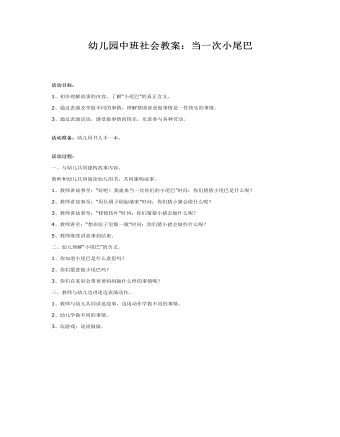
幼儿园中班社会教案:当一次小尾巴
2、通过表演及学做不同的事情,理解帮助爸爸做事情是一件快乐的事情。 3、通过表演活动,感受做事情的快乐,乐意参与各种劳动。 活动准备:幼儿用书人手一本。 活动过程: 一、与幼儿共同建构故事内容。 教师和幼儿共同阅读幼儿用书,共同建构故事。 1、教师讲故事至:“好吧!我就来当一次你们的小尾巴”时问:你们猜猜小尾巴是什么呢? 2、教师讲故事至:“用长刷子刷起墙来”时问:你们猜小猪会做什么呢? 3、教师讲故事至:“修修枝叶”时问:你们猜猜小猪会做什么呢? 4、教师讲至:“想在院子里歇一歇”时问:你们猜小猪会做些什么呢? 5、教师继续讲故事到结束。
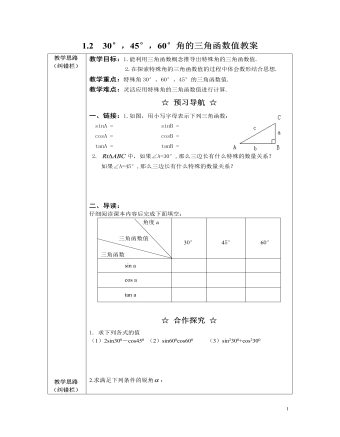
北师大初中九年级数学下册30°,45°,60°角的三角函数值2教案
教学目标:1.能利用三角函数概念推导出特殊角的三角函数值.2.在探索特殊角的三角函数值的过程中体会数形结合思想.教学重点:特殊角30°、60°、45°的三角函数值.教学难点:灵活应用特殊角的三角函数值进行计算.☆ 预习导航 ☆一、链接:1.如图,用小写字母表示下列三角函数:sinA = sinB =cosA = cosB =tanA = tanB =2. 中,如果∠A=30°,那么三边长有什么特殊的数量关系?如果∠A=45°,那么三边长有什么特殊的数量关系?二、导读:仔细阅读课本内容后完成下面填空:
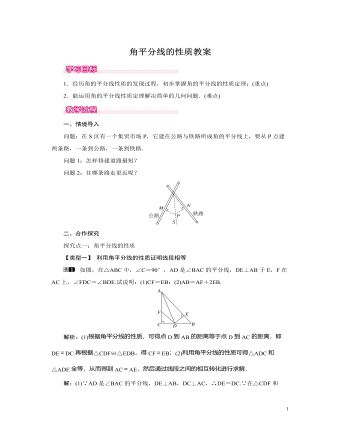
北师大初中七年级数学下册角平分线的性质教案
解析:根据AB∥CD,∠ACD=120°,得出∠CAB=60°.再根据尺规作图得出AM是∠CAB的平分线,即可得出∠MAB的度数.解:∵AB∥CD,∴∠ACD+∠CAB=180°.又∵∠ACD=120°,∴∠CAB=60°.由尺规作图知AM是∠CAB的平分线,∴∠MAB=12∠CAB=30°.方法总结:通过本题要掌握角平分线的作图步骤,根据作图明确AM是∠BAC的角平分线是解题的关键.三、板书设计1.角平分线的性质:角平分线上的点到这个角的两边的距离相等.2.角平分线的作法本节课由于采用了动手操作以及讨论交流等教学方法,从而有效地增强了学生对角以及角平分线的性质的感性认识,提高了学生对新知识的理解与感悟,因而本节课的教学效果较好,学生对所学的新知识掌握较好,达到了教学的目的.不足之处是少数学生在性质的运用上还存在问题,需要在今后的教学与作业中进一步的加强巩固和训练
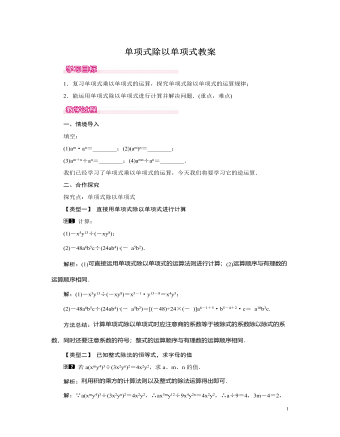
北师大初中七年级数学下册单项式除以单项式教案
光的速度约为3×108米/秒,一颗人造地球卫星的速度是8×103米/秒,则光的速度是这颗人造地球卫星速度的多少倍?解析:要求光速是人造地球卫星的速度的倍数,用光速除以人造地球卫星的速度,可转化为单项式相除问题.解:(3×108)÷(8×103)=(3÷8)·(108÷103)=3.75×104.答:光速是这颗人造地球卫星速度的3.75×104倍.方法总结:解整式除法的实际应用题时,应分清何为除式,何为被除式,然后应当单项式除以单项式法则计算.三、板书设计1.单项式除以单项式的运算法则:单项式相除,把系数、同底数幂分别相除,作为商的因式;对于只在被除式里含有的字母,则连同它的指数作为商的一个因式.2.单项式除以单项式的应用在教学过程中,通过生活中的情景导入,引导学生根据单项式乘以单项式的乘法运算推导出其逆运算的规律,在探究的过程中经历数学概念的生成过程,从而加深印象
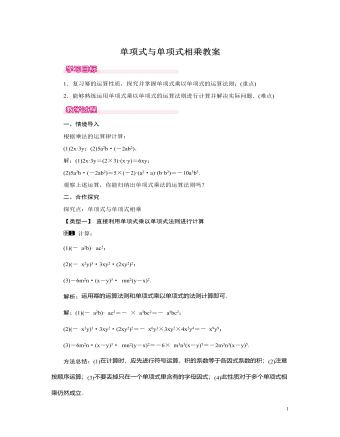
北师大初中七年级数学下册单项式与单项式相乘教案
解析:先求出长方形的面积,再求出绿化的面积,两者相减即可求出剩下的面积.解:长方形的面积是xym2,绿化的面积是35x×34y=920xy(m2),则剩下的面积是xy-920xy=1120xy(m2).方法总结:掌握长方形的面积公式和单项式乘单项式法则是解题的关键.三、板书设计1.单项式乘以单项式的运算法则:单项式相乘,把系数、同底数幂分别相乘,作为积的因式;对于只在一个单项式里面含有的字母,则连同它的指数作为积的一个因式.2.单项式乘以单项式的应用本课时的重点是让学生理解单项式的乘法法则并能熟练应用.要求学生在乘法的运算律以及幂的运算律的基础上进行探究.教师在课堂上应该处于引导位置,鼓励学生“试一试”,学生通过动手操作,能够更为直接的理解和应用该知识点
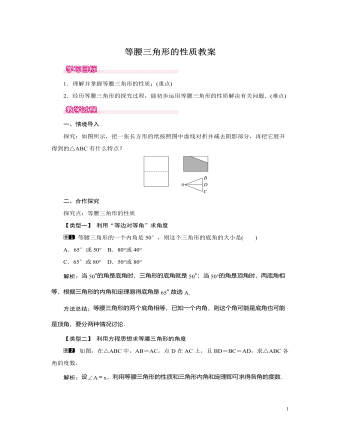
北师大初中七年级数学下册等腰三角形的性质教案
方法总结:在等腰三角形有关计算或证明中,会遇到一些添加辅助线的问题,其顶角平分线、底边上的高、底边上的中线是常见的辅助线.三、板书设计1.等腰三角形的性质:等腰三角形是轴对称图形;等腰三角形顶角的平分线、底边上的中线、底边上的高重合(也称“三线合一”),它们所在的直线都是等腰三角形的对称轴;等腰三角形的两个底角相等.2.运用等腰三角性质解题的一般思想方法:方程思想、整体思想和转化思想.本节课由于采用了直观操作以及讨论交流等教学方法,从而有效地增强了学生的感性认识,提高了学生对新知识的理解与感悟,因而本节课的教学效果较好,学生对所学的新知识掌握较好,达到了教学的目的.不足之处是少数学生对等腰三角形的“三线合一”性质理解不透彻,还需要在今后的教学和作业中进一步巩固和提高
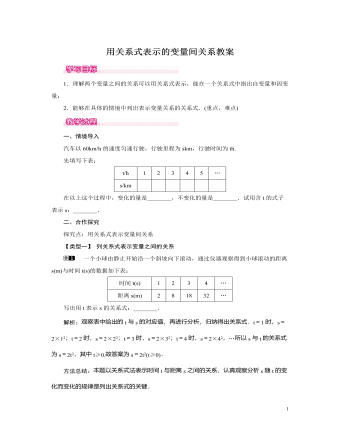
北师大初中七年级数学下册用关系式表示的变量间关系教案
方法总结:观察表中的数据,发现其中的变化规律,然后根据其增减趋势写出自变量与因变量之间的关系式.三、板书设计1.用关系式表示变量间关系2.表格和关系式的区别与联系:表格能直接得到某些具体的对应值,但不能直接反映变量的整体变化情况;用关系式表示变量之间的关系简单明了,便于计算分析,能方便求出自变量为任意一个值时,相对应的因变量的值,但是需计算.本节课的教学内容是变量间关系的另一种表示方法,这种表示方法学生才接触到,学生感觉有点难.这节课的重点是让学生掌握用关系式与表格表示变量间的关系,难点是理解这两种表示方法的优缺点.就此问题,通过让学生对几个例子比较、讨论、总结、归纳两种方法的优点来解决,这样学生就能很好地区分这两种表示方法,并能对不同的问题选择恰当的方法
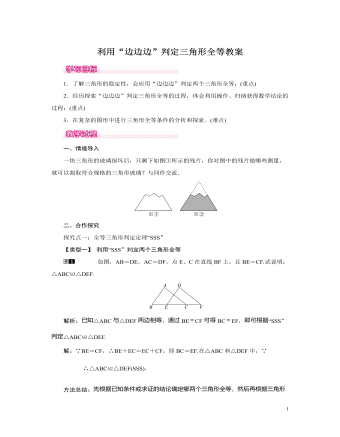
北师大初中七年级数学下册利用“边边边”判定三角形全等教案
解析:由于多边形(三边以上的)不具有稳定性,将其转化为三角形后木架的形状就不变了.根据具体多边形转化为三角形的经验及题中所加木条可找到一般规律.解:过n边形的一个顶点可以作(n-3)条对角线,把多边形分成(n-2)个三角形,所以,要使一个n边形木架不变形,至少需要(n-3)根木条固定.方法总结:将多边形转化为三角形时,所需要的木条根数,可从具体到一般去发现规律,然后验证求解.三、板书设计1.边边边:三边对应相等的两个三角形全等,简写成“边边边”或“SSS”.2.三角形的稳定性本节课从操作探究活动入手,有效地激发了学生的学习积极性和探究热情,提高了课堂的教学效率,促进了学生对新知识的理解和掌握.从课堂教学的情况来看,学生对“边边边”掌握较好,达到了教学的预期目的.存在的问题是少数学生在辅助线的构造上感到困难,不知道如何添加合理的辅助线,还需要在今后的教学中进一步加强巩固和训练
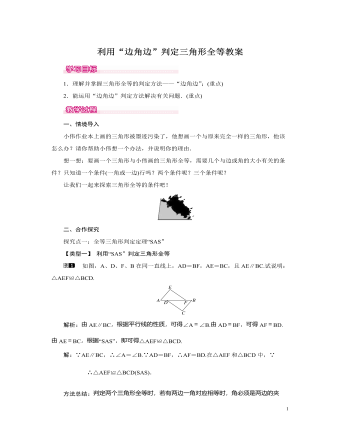
北师大初中七年级数学下册利用“边角边”判定三角形全等教案
AD=CD,∠ADE=∠CDG,DE=GD,∴△ADE≌△CDG(SAS),∴AE=CG;(2)设AE与DG相交于M,AE与CG相交于N.在△GMN和△DME中,由(1)得∠CGD=∠AED,又∵∠GMN=∠DME,∠DEM+∠DME=90°,∴∠CGD+∠GMN=90°,∴∠GNM=90°,∴AE⊥CG.三、板书设计1.边角边:两边及其夹角分别相等的两个三角形全等,简写成“边角边”或“SAS”.两边和其中一边的对角对应相等的两个三角形不一定全等.2.全等三角形判定与性质的综合运用本节课从操作探究入手,具有较强的操作性和直观性,有利于学生从直观上积累感性认识,从而有效地激发了学生的学习积极性和探究热情,提高了课堂的教学效率,促进了学生对新知识的理解和掌握.从课堂教学的情况来看,学生对“边角边”掌握较好,但在探究三角形的大小、形状时不会正确分类,需要在今后的教学和作业中进一步加强分类思想的巩固和训练
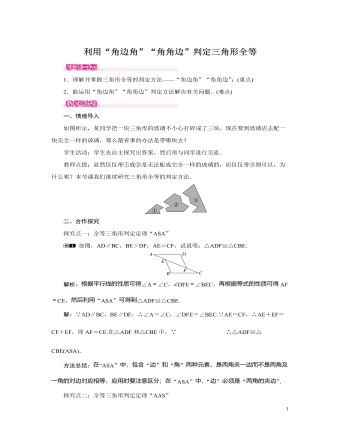
北师大初中七年级数学下册利用“角边角”“角角边”判定三角形全等教案
1.理解并掌握三角形全等的判定方法——“角边角”“角角边”;(重点)2.能运用“角边角”“角角边”判定方法解决有关问题.(难点) 一、情境导入如图所示,某同学把一块三角形的玻璃不小心打碎成了三块,现在要到玻璃店去配一块完全一样的玻璃,那么最省事的办法是带哪块去?学生活动:学生先自主探究出答案,然后再与同学进行交流.教师点拨:显然仅仅带①或②是无法配成完全一样的玻璃的,而仅仅带③则可以,为什么呢?本节课我们继续研究三角形全等的判定方法.二、合作探究探究点一:全等三角形判定定理“ASA”如图,AD∥BC,BE∥DF,AE=CF,试说明:△ADF≌△CBE.解析:根据平行线的性质可得∠A=∠C,∠DFE=∠BEC,再根据等式的性质可得AF=CE,然后利用“ASA”可得到△ADF≌△CBE.
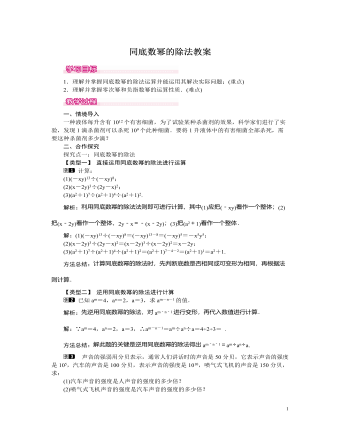
北师大初中七年级数学下册同底数幂的除法教案
【类型四】 含整数指数幂、零指数幂与绝对值的混合运算计算:-22+(-12)-2+(2015-π)0-|2-π2|.解析:分别根据有理数的乘方、零指数幂、负整数指数幂及绝对值的性质计算出各数,再根据实数的运算法则进行计算.解:-22+(-12)-2+(2015-π)0-|2-π2|=-4+4+1-2+π2=π2-1.方法总结:熟练掌握有理数的乘方、零指数幂、负整数指数幂及绝对值的性质是解答此题的关键.三、板书设计1.同底数幂的除法法则:同底数幂相除,底数不变,指数相减.2.零次幂:任何一个不等于零的数的零次幂都等于1.即a0=1(a≠0).3.负整数次幂:任何一个不等于零的数的-p(p是正整数)次幂,等于这个数p次幂的倒数.即a-p=1ap(a≠0,p是正整数).从计算具体问题中的同底数幂的除法,逐步归纳出同底数幂除法的一般性质.教学时要多举几个例子,让学生从中总结出规律,体验自主探究的乐趣和数学学习的魅力,为以后的学习奠定基础
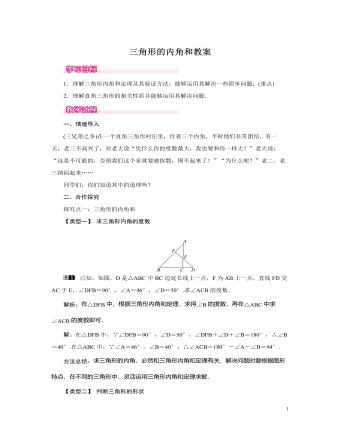
北师大初中七年级数学下册三角形的内角和教案
解:∵CE⊥AF,∴∠DEF=90°,∴∠EDF=90°-∠F=90°-40°=50°.由三角形的内角和定理得∠C+∠DBC+∠CDB=∠F+∠DEF+∠EDF,又∵∠CDB=∠EDF,∴30°+∠DBC=40°+90°,∴∠DBC=100°.方法总结:本题主要利用了“直角三角形两锐角互余”的性质和三角形的内角和定理,熟记性质并准确识图是解题的关键.三、板书设计1.三角形的内角和定理:三角形的内角和等于180°.2.三角形内角和定理的证明3.直角三角形的性质:直角三角形两锐角互余.本节课通过一段对话设置疑问,巧设悬念,激发起学生获取知识的求知欲,充分调动学生学习的积极性,使学生由被动接受知识转为主动学习,从而提高学习效率.然后让学生自主探究,在教学过程中充分发挥学生的主动性,让学生提出猜想.在教学中,教师通过必要的提示指明学生思考问题的方向,在学生提出验证三角形内角和的不同方法时,教师注意让学生上台演示自己的操作过程和说明自己的想法,这样有助于学生接受三角形的内角和是180°这一结论
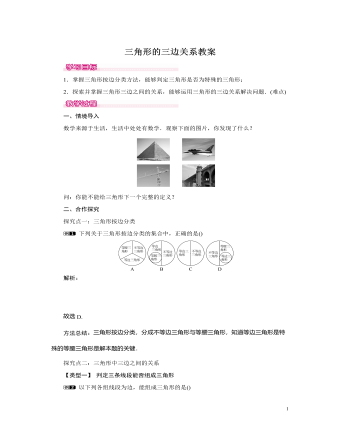
北师大初中七年级数学下册三角形的三边关系教案
方法总结:绝对值的化简首先要判断绝对值符号里面的式子的正负,然后根据绝对值的性质将绝对值的符号去掉,最后进行化简.此类问题就是根据三角形的三边关系,判断绝对值符号里面式子的正负,然后进行化简.三、板书设计1.三角形按边分类:有两边相等的三角形叫做等腰三角形,三边都相等的三角形是等边三角形,三边互不相等的三角形是不等边三角形.2.三角形中三边之间的关系:三角形任意两边之和大于第三边,三角形任意两边之差小于第三边.本节课让学生经历一个探究解决问题的过程,抓住“任意的三条线段能不能围成一个三角形”引发学生探究的欲望,围绕这个问题让学生自己动手操作,发现有的能围成,有的不能围成,由学生自己找出原因,为什么能?为什么不能?初步感知三条边之间的关系,重点研究“能围成三角形的三条边之间到底有什么关系”.通过观察、验证、再操作,最终发现三角形任意两边之和大于第三边这一结论.这样教学符合学生的认知特点,既增加了学习兴趣,又增强了学生的动手能力

北师大初中七年级数学下册用表格表示的变量间关系教案
解:(1)电动车的月产量y为随着时间x的变化而变化,有一个时间x就有唯一一个y与之对应,月产量y是时间x的因变量;(2)6月份产量最高,1月份产量最低;(3)6月份和1月份相差最大,在1月份加紧生产,实现产量的增值.方法总结:观察因变量随自变量变化而变化的趋势,实质是观察自变量增大时,因变量是随之增大还是减小.三、板书设计1.常量与变量:在一个变化过程中,数值发生变化的量为变量,数值始终不变的量称之为常量.2.用表格表示数量间的关系:借助表格表示因变量随自变量的变化而变化的情况.自变量和因变量是用来描述我们所熟悉的变化的事物以及自然界中出现的一些变化现象的两个重要的量,对于我们所熟悉的变化,在用了这两个量的描述之后更加鲜明.本节是学好本章的基础,教学中立足于学生的认知基础,激发学生的认知冲突,提升学生的认知水平,使学生在原有的知识基础上迅速迁移到新知上来

